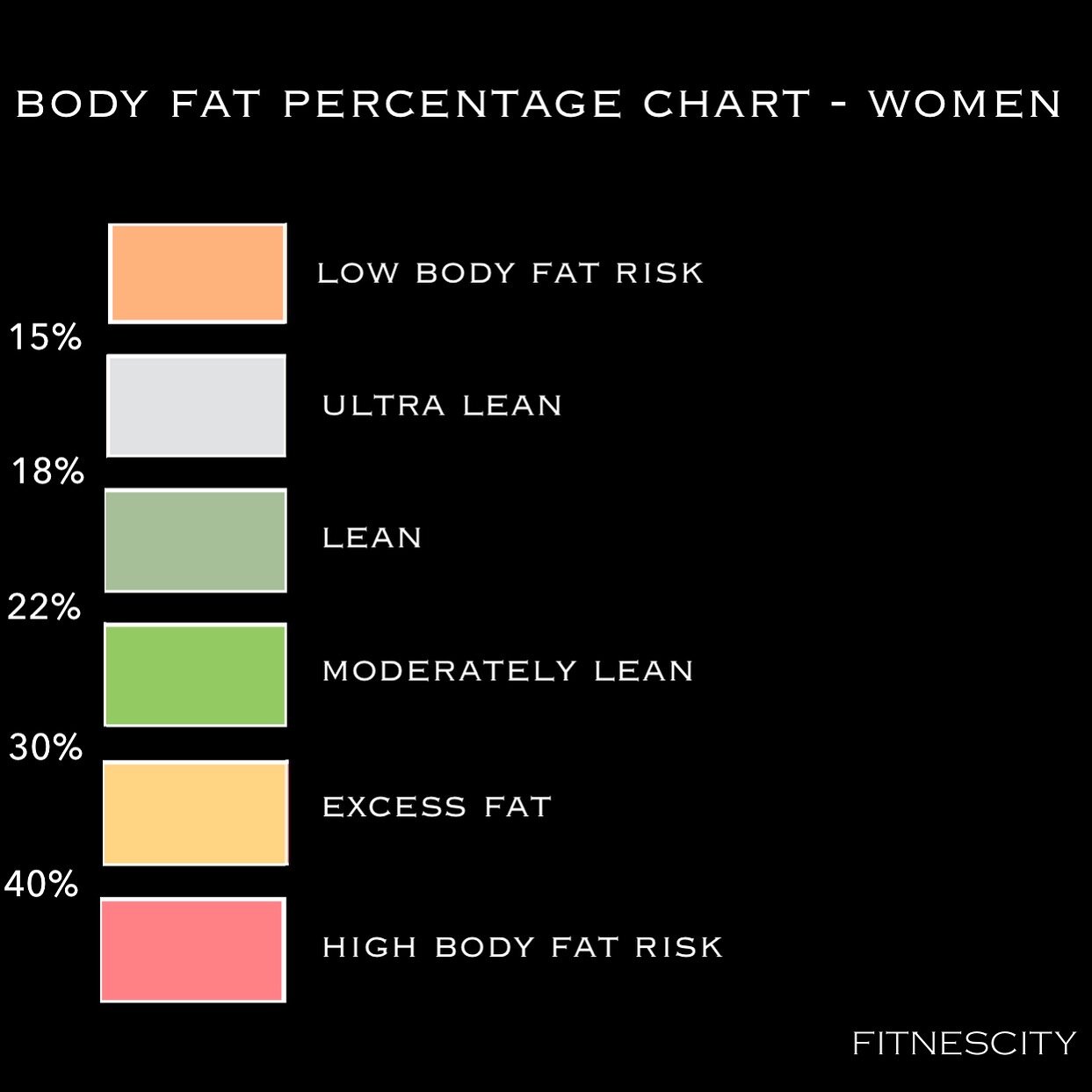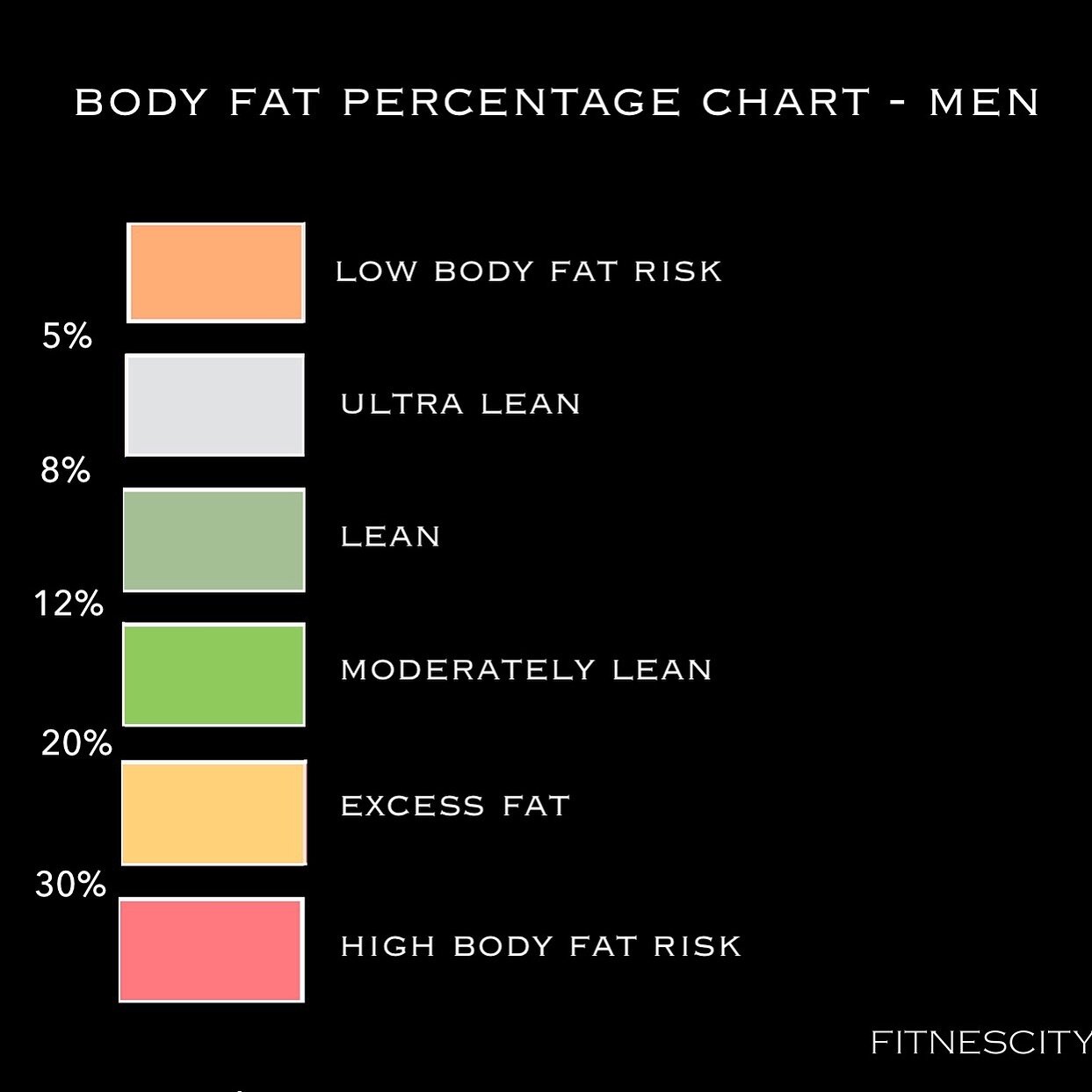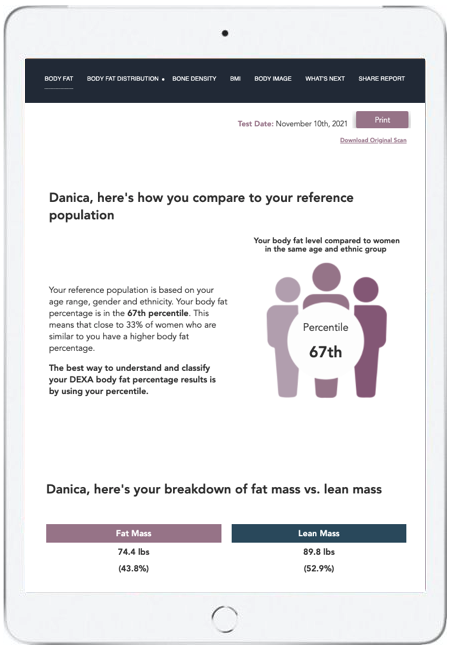Store locator is loading from StoreRocket Store Locator Widget..
Measure Body Fat Percentage
Popular locations
DEXA scan in NYC | DEXA scan in Boston | DEXA scan in Philadelphia. DEXA scan in Miami | DEXA scan in Salt Lake City | DEXA scan in San Francisco | DEXA scan in the Bay Area.
All locations
Why Do Body Fat Percentages Matter?
Body fat percentage charts can be immensely useful when body fat is measured accurately. Tests such as DEXA, BOD POD and SECA take into account your individual traits and characteristics, to produce results with real insights. The results include a real breakdown of your body, into fat and fat-free mass (lean muscle, bone, tissue, water).
While generic formulas attempt to estimate body fat percentage by using broad categories like height, weight, sex and age as reference points, the result can often be misleading.
Getting an accurate measurement of your body fat percentage allows you to better understand your body and track your progress over time as you retest every 4, 6, or 12 months.
Body Fat Percentage: The Basics
The body fat percentage (BFP) is the total mass of fat divided by total body mass, times 100. Total body fat includes two types of fat: essential body fat and storage body fat.
Essential body fat
Essential fat is necessary to maintain life and reproductive functions. Women have higher body fat and essential body fat percentages relative to men for any given level of fitness. This difference is attributed to physiological differences, such as hormones, ovulation and childbearing.
The percentage of essential fat is 4–5% in men, and 10–13% in women.
Storage body fat
Storage body fat consists of fat accumulation in adipose tissue. The main role of adipose tissue is to store energy in the form of lipids, although it also cushions and insulates the body, protecting internal organs in the chest and abdomen. While some storage body fat is needed, excess accumulation of fat can be harmful.
Body Fat Percentage Charts
Your body fat percentage can indicate whether you fall within the "low body fat risk", "ulra lean", "moderately lean", "excess fat" or "high body fat risk" zone.
Looking Deeper
We know that Body Mass Index (BMI) ranges are outdated, but what is a healthy, sustainable body fat percentage range that we should aim for?
We compiled information from some of the world's most reliable sources. The body fat classification below is based on information from Cosmed, the manufacturer of the BOD POD body composition machine. It is also based information from the American College of Sports Medicine, the American Council on Exercise, Essentials of Exercise Physiology (4th Ed) by McArdle, Katch & Katch and various epidemiological studies. It is used by Fitnescity, as well as by prominent health institutions in the country, such as Mount Sinai's Metabolic, Body Composition, and Sports Performance Clinic.
This classification applies to individuals 18 and older and is divided in two categories: body fat percentage chart for women and body fat percentage chart for men.
Body Fat Percentage Classification
Body fat percentage: classification - Women
Under 15%: Low Body Fat Risk.
15%-18%: Ultra Lean.
18%-22%: Lean.
22%-30%: Moderately Lean.
30%-40%: Excess Fat.
Above 40%: High Body Fat Risk.
Body fat percentage: classification - men
Under 5%: Low Body Fat Risk.
5%-8%: Ultra Lean.
8%-12%: Lean.
12%-20%: Moderately Lean.
20%-30%: Excess Fat.
Above 30%: High Body Fat Risk.
Get a BOD POD Body Fat Test
Get a DEXA Scan Assessment
How to Measure Body Fat Percentage
1. DEXA / DXA SCAN
DEXA / DXA Scan is widely considered as one of the most accurate and comprehensive body composition tests. The DEXA scan utilizes dual-energy X-ray absorptiometry (DXA). The test looks beyond your weight and the traditional body mass index (BMI). It determines your total body fat percentage, total fat mass and fat-free mass. Most importantly, DEXA body composition technology provides regional body fat results (trunk, arms, legs, pelvis and android/gynoid regions). A DEXA scan can also measure visceral fat / abdominal fat, which is often associated with increased risk for cardiovascular disease and type 2 diabetes. DEXA results often include bone density as well (bone mineral density - BMD).
2. BOD POD
Based on Air Displacement Plethysmography, the BOD POD uses whole body densitometric principles to determine body composition (Fat and Fat-Free Mass), guaranteeing high accuracy and excellent test-to-test repeatability.
The BOD POD’s air displacement plethysmography eliminates the invasiveness of Dual Energy X-Ray Absorptiometry (DEXA) and is therefore suitable for frequent, longitudinal tracking of body composition and metabolic changes over time.
3.Underwater / Hydrostatic Weighing
Hydrostatic weighing, or underwater weighing, compares your normal body weight (outside the water) to your body weight while completely submerged in the water. Using these two numbers and the density of the water, operators can accurately determine body volume and density, along with the breakdown of fat mass vs. fat-free mass.
4. Skinfold Calipers
This is one of the most accessible methods for measuring body composition. The skinfold assessment measures the thicknesses of skin and the subcutaneous fat at four to six locations in the body. This includes the triceps, shoulder blade, love handle area, abdomen and calves. The Skinfold should not include muscle and fascia in order to ensure accuracy.
Once the test is completed, the measurements are put into a formula for the practitioner to estimate body composition.
5. Bio-Impedence (scales)
Bio-impedence involves standing on a scale, and in some cases pushing the buttons of two electrodes that are placed in your hands. A low level (and imperceptible) electrical current is then sent through the body. Tissues that contain fluid and electrolytes, such as blood, have high conductivity, while fat and bone slow the signal down. As Bio-impedence determines the resistance to the current as it passes through the body, it provides estimates of body water and body fat.
Digging a little deeper, visceral fat is of particular concern. Visceral fat lies out of reach, deep within the abdominal cavity, where it pads the spaces between our abdominal organs. It is a key player in a variety of health problems — much more so than subcutaneous fat, the kind you can grasp (or "pinch") with your hand.
The good news is that visceral fat yields fairly easily to exercise and diet. However, Subcutaneous fat located at the waist — the “pinchable” stuff — can be frustratingly difficult to budge, but in normal-weight people, it's generally not considered as much of a health threat as visceral fat is.
Visceral Fat: The Invisible Health Risk
Abdominal, or visceral, fat is important to know because it is a key player in a variety of health problems — much more so than subcutaneous fat, the kind we are all familiar with and that one can grasp with their hand. Visceral fat, on the other hand, lies out of reach, deep within the abdominal cavity, where it pads the spaces between our abdominal organs.
Visceral fat has been linked to metabolic disturbances and increased risk for cardiovascular disease and type 2 diabetes. In women, it is also associated with breast cancer and the need for gallbladder surgery.
It is well-established that both the distribution and volume of fat, especially visceral adipose tissue (VAT), is a predictor of future health. While normal amounts of visceral fat pad and protect organs, an excess amount of VAT is strongly associated with metabolic syndrome and increases health risks for cancer, stroke, diabetes, cardiovascular disease, and hypertension. Excess VAT can impact lifestyle by increasing the risk of dementia, depression, arthritis, sexual dysfunction, and sleep disorders. Storing excess fat around the organs increases the production of inflammatory substances that interfere with hormones that control appetite, weight, mood, and brain function.
Visceral Fat: How to Measure It
There are several methods for quantifying VAT, including waist-to-hip measurement, bioelectrical impedance, dual-energy absorptiometry (DEXA), CT, MRI, and ultrasound. Although CT is considered the gold standard because of its accuracy and reliability, its drawbacks are exposure to ionizing radiation and the relatively high cost of a CT exam. DEXA has been found to be an accurate means for measuring VAT volume and is generally more accessible to the general population.
The DEXA body composition scan offers several advantages compared to CT including reduced radiation dose, decreased scan times, and lower cost.4 Importantly, obtaining VAT measurements with DEXA is easily performed in conjunction with evaluation of bone mineral density, fracture assessment and risk, and whole body composition.
Learn more: Visceral Fat: The Invisible Health Risk, Vyvyane Loh, MD CEO and Medical Director Transform Institute for Metabolic & Lifestyle Medicine.
Difference between body fat percentage and BMI
The Body Mass Index (BMI) was created in the mid-19th century by Adolphe Quetelet, and it has prevailed since then. It is commonly used as a screening tool for overweight and obesity. However, BMI has several limitations and can sometimes lead to screening errors.
BMI Definition
The BMI is defined as the body mass divided by the square of the body height, and is universally expressed in units of kg/m2, resulting from mass in kilograms and height in meters. Here’s a simple tool for calculating BMI.
The BMI is often used to classify individuals in one of the following categories: underweight, normal weight, overweight, or obese.
BMI History
The basis of the BMI was devised by Adolphe Quetelet, a Belgian astronomer, mathematician, statistician and sociologist, from 1830 to 1850 during which time he developed what he called "social physics."
The modern term "body mass index" (BMI) for the ratio of human body weight to squared height was coined in a paper published in the July 1972 edition of the Journal of Chronic Diseases by Ancel Keys. In this paper, Keys argued that what he termed the BMI was "...if not fully satisfactory, at least as good as any other relative weight index as an indicator of relative obesity."
Why You Should Rely on Body Fat Percentage over BMI
The medical establishment and statistical community have both highlighted the limitations of BMI.
(1) BMI DOES NOT DIFFERENTIATE BETWEEN BODY FAT AND LEAN MASS
(2) BMI DOES NOT INDICATE WEIGHT DISTRIBUTION.
Individuals with a similar BMI could have drastically different body shapes, and thus varying risk of disease and early mortality.
Body Fat Percentage and Age
There are currently no official charts or recommendations for body fat percentage by age. This can be somewhat frustrating when using body fat percentage as an indicator of physical fitness. Achieving a lower body fat percentage tends to get harder with age and therefore demands greater effort and discipline. When assessing body fat percentage by age (in the absence of an official chart), it is recommended to compare individuals based on population data. This reference data can be hard to find. At Fitnescity, since we measure body fat percentage through a variety of tests, we are able to generate body fat reports that compare test results with the rest of the population every time someone completes a test. This provides an accurate assessment of where an individual stands compared to their age group.
Body Fat Percentage Chart
| Classification | Women | Men |
|---|---|---|
| Low Body Fat Risk | Under 15% | Under 5% |
| Ultra Lean | 15-18% | 5-8% |
| Lean | 18-22% | 8-12% |
| Moderately Lean | 22-30% | 12-20% |
| Excess Fat | 30-40% | 20-30% |
| High Body Fat Risk | Above 40% | Above 30% |
Get a BOD POD Body Composition Test
Get a DEXA Scan (Note: This classification does not apply to DEXA scan results).
Body Water Percentage
How much of your body is "body water?”
Conventional wisdom tells us that we're made up of mostly water. But exactly how much of the human body consists of H2O? If you're an adult, the answer is about 60 percent, but the total changes with age, weight, geography, and other variables. For example, newborn babies have a water weight of about 78 percent, which dips to 70 percent by the time they have their first taste of birthday cake. Starting at puberty, the average man contains a slightly higher water percentage than the average woman. Older adults begin to lose hydration compared to younger adults. In general, a healthy adult's body is composed of at least 50 percent water.
Read more about body water under What Percentage of the Human Body Is Water?
Is 15% Really the Magic Number for Body Fat for Men?
For some men in the fitness realm, the goal of 15 percent body fat has reached nearly mythical proportions. To understand why this number is such a common body composition goal it helps to understand what the body looks like and the physical effects that occur at each fat percentage level. Should you jump on the 15% body fat bandwagon? What does your body composition mean for your health? Find out more in this guide on body fat percentage levels for men.
Can I Know My VO2 Max If I Measure My Body Fat Percentage?
VO2 Max (also maximal oxygen consumption, maximal oxygen uptake, peak oxygen uptake or maximal aerobic capacity) is the maximum rate of oxygen consumption measured during incremental exercise (exercise of increasing intensity).
Maximal oxygen consumption reflects the overall cardiorespiratory fitness of an individual. It is an excellent way to assess an individual’s fitness level.
Having a good fitness level significantly reduces your likelihood of developing chronic illness. For both moderately active individuals and athletes, VO2max assessment is vital for training and performance.
While it is true that the VO2 Max test—just like body fat percentage—can help determine physical fitness and overall cardiovascular health, there is no known correlation between body fat percentage and VO2 max. In other words, even the most accurate body fat test, such as the DEXA and the BOD POD, cannot use body fat percentage results to predict VO2 max and vice versa.




